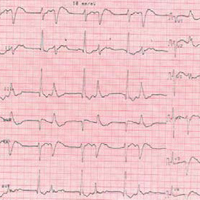 Smart Citations
Smart CitationsSee how this article has been cited at scite.ai
scite shows how a scientific paper has been cited by providing the context of the citation, a classification describing whether it supports, mentions, or contrasts the cited claim, and a label indicating in which section the citation was made.
A perfect refractory electrical storm by acute toxicity of accidental aconitine intake
A 51-years-old male presented with drooling, hematemesis and diarrhea in emergency department after accidental ingestion of homemade aconitine tincture. Examination revealed shock and initial ECG showed atrial fibrillation. The patient suddenly developed a pulseless wide QRS complex tachycardia requiring resuscitation maneuvers. The rhythm varied from monomorphic ventricular tachycardia to torsade de point to ventricular fibrillation. Repeated direct-current cardioversions were unsuccessful. After intravenous electrolyte correction and anti-arrhythmic drugs administration, a last direct-current shock was finally successful. Bradycardia and ventricular excitability persisted over 12 hours with gradual normalization. Patient was discharged in normal sinus rhythm without any medication and on follow-up he was totally asymptomatic.
With the increasing popularity of traditional medicine, clinicians should be alerted to the risk of herbal substances with low margins of safety like Aconitum in order to allow correct diagnosis and treatment. The general public should be educated that herbal medicine is not always safe.
Downloads
How to Cite
PAGEPress has chosen to apply the Creative Commons Attribution NonCommercial 4.0 International License (CC BY-NC 4.0) to all manuscripts to be published.

 https://doi.org/10.4081/ecj.2021.9736
https://doi.org/10.4081/ecj.2021.9736





